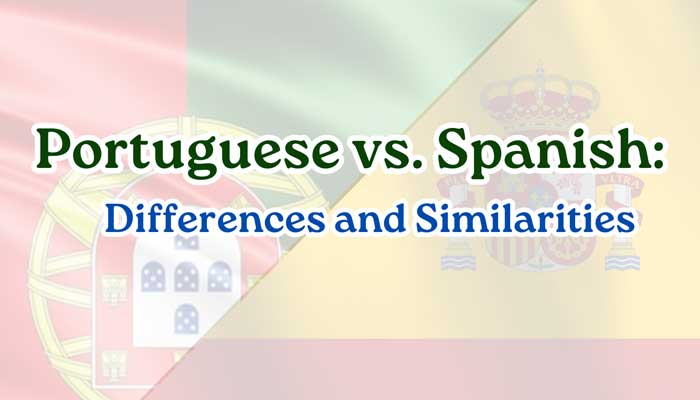Portuguese and Spanish, both Romance languages with Latin origins, share many similarities, but also exhibit distinct characteristics that set them apart. In this article, we will explore the differences and similarities between the two languages.
Common origin
Both languages are from the Romance language family, which developed from Vulgar Latin during the decline of the Roman Empire. This shared ancestry roots that these languages have many structural and lexical similarities.
Similarities
– Grammar and Verb Conjugation
Both share a similar verb conjugation system, with tenses such as present, past and future being expressed in comparable ways.
– Cognates
Both have a multitude of cognates – words that are similar in form and meaning – thanks to their common Latin roots. For example, “nación” in Spanish and “nação” in European Portuguese, both meaning “nation”.
– Nouns and adjectives with gender
Like other Romance languages, nouns in Portuguese and Spanish have gender, being masculine or feminine.
– Pluralisation
The formation of plurals is often similar, typically involving the addition of “-s” or “-es” to the end of nouns.
– Definite and Indefinite Articles
Both languages have definite articles (“o/a” in Portuguese, “el/la” in Spanish) and indefinite articles (“um/uma” in Portuguese, “un/una” in Spanish).
Pronunciation and Phonetics
Although European Portuguese and Spanish share some phonetic elements, there are differences in pronunciation that can affect mutual understanding.
Differences
– Hissing Sounds
Spanish tends to have a clearer pronunciation of hissing sounds like “s” and “z.” European Portuguese, on the other hand, often softens or eliminates these sounds, making the pronunciation less sharp.
– Nasalization
European Portuguese has nasalized vowels, indicated by stress marks such as the tilde (~) over the vowels (for example, “ão”). Spanish does not have nasalized vowels.
– Pronunciation of consonants
Both differ in the pronunciation of certain consonants. For example, the “r” in European Portuguese is often pronounced as a guttural sound, while the “r” in Spanish is usually rolled or tapped.
Vocabulary and Lexical Differences
Despite their linguistic kinship, Portuguese and Spanish have distinct vocabularies, and there are many words that exist in one language but not in the other.
Differences
– False Cognates
False cognates (or false friends) are common between European and Spanish, where words may look or sound similar but have different meanings. For example, “embarazada” means “pregnant” in Spanish, but “embaraçada” means “embarrassed” in Portuguese.
– Unique Expressions
Each language has idiomatic expressions and colloquialisms that are not directly translatable. For example, the Portuguese expression “saudade” captures a deep, nostalgic feeling, but there is no direct equivalent in Spanish.
Grammar and Verb Tenses
Although European Portuguese and Spanish share similarities in their grammar, there are differences in verb tenses and grammatical structures.
Differences
– Use of Future Tenses
European Portuguese uses the future of subjunctive more frequently than Spanish. Spanish often uses the present of subjunctive in similar contexts.
– Past times
Both languages have different past tenses to convey nuances of time. Spanish uses the past tense and imperfect, while European Portuguese relies on the preterit, imperfect, and compound perfect preterit.
Regional Variations
Just as English varies between regions, Portuguese and Spanish also exhibit regional differences in vocabulary, pronunciation and even grammar. These variations can sometimes lead to misunderstandings.
Differences
– Dialects
Spanish has a wide variety of dialects, including Castilian Spanish, Latin American Spanish, and regional dialects such as Andalusian and Rioplatense. Portuguese also has variants, such as Brazilian Portuguese, European Portuguese and African dialects.
– Vocabulary
There are distinct regional vocabulary differences in both languages. For example, the word for “bus” in European Portuguese is “autocarro”, while in Brazilian Portuguese it is “ônibus”.
Mutual Intelligibility
Despite their differences, speakers of European Portuguese and Spanish can often understand each other quite well due to their shared linguistic roots.
Similarities
– Lexical Overlap
Many words in European Portuguese and Spanish are identical or very similar, making them easier to understand.
– Contextual Tips
Even when encountering unfamiliar words, the context often allows speakers of one language to understand the meaning in the other.
How Spanish Speakers Can Learn European Portuguese Quickly
Taking Advantage of Linguistic Similarities
1. Cognates and Common Vocabulary
One of the biggest advantages of being a Spanish speaker when learning European Portuguese is the abundance of cognates. Many words in European Portuguese have close equivalents in Spanish.
2. Text Comprehension
With the similar lexical base between the two languages, Spanish speakers can often understand the general context of a European Portuguese text, even without understanding all the words.
Efficient Approaches
3. Conversation Classes
Conversational practice is essential to deepen understanding and fluency in any language. Taking conversation classes with native European Portuguese speakers can help you adapt your pronunciation and fluency quickly.
Practical Tips
4. Writing Practice
In addition to speaking, writing practice is crucial to deepening your knowledge of the language. Start by writing short texts in European Portuguese, such as personal diaries or news summaries. Ask a native speaker or tutor to review and correct your writing. This will help improve your grammar and syntax.
Facing the Challenges
5. Awareness of Differences
While the similarities are notable, it is important to be aware of the significant differences. The main differences include pronunciation, accentuation rules, verb conjugation and grammatical peculiarities. Pay attention to these areas to avoid common mistakes.
Conclusion
Although differences in the areas of pronunciation, vocabulary and grammar can make learning one language from another challenging, the common basis of both languages provides the opportunity for communication and mutual understanding.
For Spanish speakers, the journey of learning European Portuguese can be a rewarding experience, taking advantage of the linguistic similarities and cultural richness shared between these two languages. If you know Spanish, take the most of these advantages.

